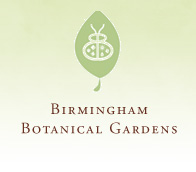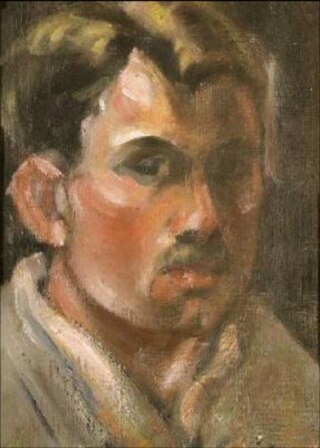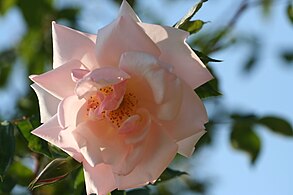
Descanso Gardens is a 150-acre (61 ha) botanical garden located in La Cañada Flintridge, Los Angeles County, California. It sits on the northern edge of the San Rafael Hills.
The culture of Los Angeles is rich with arts and ethnically diverse. The greater Los Angeles metro area has several notable art museums including the Los Angeles County Museum of Art (LACMA), the J. Paul Getty Museum on the Santa Monica Mountains overlooking the Pacific, the Museum of Contemporary Art (MOCA), and the Hammer Museum. In the 1920s and 1930s Will Durant and Ariel Durant, Arnold Schoenberg and other intellectuals were the representatives of culture, in addition to the movie writers and directors. As the city flourished financially in the middle of the 20th century, culture followed. Boosters such as Dorothy Buffum Chandler and other philanthropists raised funds for the establishment of art museums, music centers and theaters. Today, the Southland cultural scene is as complex, sophisticated and varied as any in the world.

The Christchurch Botanic Gardens, located in the central city of Christchurch, New Zealand, were founded in 1863 when an English oak was planted to commemorate the solemnisation of the marriage of Prince Albert and Princess Alexandra of Denmark. The gardens sprawl over an area of 21 hectares and lie adjacent to the loop of the Avon River next to Hagley Park. The Christchurch Botanic Gardens have a variety of collections of exotic and local plants of New Zealand, several conservatories, a nursery, playground and Climatological Station.

The Birmingham Botanical Gardens is 67.5-acre (27.3 ha) of botanical gardens located adjacent to Lane Park at the southern foot of Red Mountain in Birmingham, Alabama. The gardens are home to over 12,000 different types of plants, 25 unique gardens, more than 30 works of original outdoor sculpture, and several miles of walking paths. With more than 350,000 annual visitors, the Birmingham Botanical Gardens qualify as one of Alabama's top free-admittance tourist attractions. The Birmingham Botanical Gardens is also a part of the American Public Gardens Association.
Laura Skandera Trombley is an American academic administrator and scholar of Mark Twain. She is the Chair Emerita of the J. William Fulbright Foreign Scholarship Board and was the fifth President of Pitzer College in Claremont, California, and the eighth President of the Huntington Library, Art Collections and Botanical Gardens in San Marino, California. In March 2018, she was named as the tenth president of University of Bridgeport in Bridgeport, Connecticut. On April 2, 2020, Skandera Trombley was named the 16th president of Southwestern University.

The Palm Springs Art Museum is a visual and performing arts institution with several locations in the Coachella Valley, in Riverside County, California, United States, founded in 1938. PSAM has been focused on design and contemporary art since 2004. PSAM houses an art museum and an Architecture and Design Center in Palm Springs, California, along with the Faye Sarkowsky Sculpture Garden at a satellite location in Palm Desert.

The Huntington Museum of Art is a nationally accredited art museum located in the Park Hills neighborhood above Ritter Park in Huntington, West Virginia. Housed on over 50 acres of land and occupying almost 60,000 square feet, it is the largest art museum in the state of West Virginia. The museum's campus is home to nature trails and the C. Fred Edwards Conservatory, a subtropical and tropical plant conservatory. The museum's collection includes American and European paintings, sculptures, prints, and drawings, as well as glass pieces manufactured in West Virginia and the Ohio Valley, American folk art, Chinese and Japanese decorative objects, Haitian art, firearms, and decorative arts from the Near East. In addition to its permanent collections, the museum hosts traveling exhibitions and houses the James D. Francis Art Research Library, the Grace Rardin Doherty Auditorium, and five art studios where artists in residence are periodically hosted and classes are held. The Huntington Museum of Art holds one of the largest collections of art in the state of West Virginia.

Arabella Duval Huntington was an American philanthropist and once known as the richest woman in the country as a result of inheritances she received upon the deaths of her husbands. She was the force behind the art collection that is housed at the Huntington Library in California.

Pinkie is the traditional title for a portrait made in 1794 by Thomas Lawrence in the permanent collection of the Huntington Library at San Marino, California where it normally hangs opposite The Blue Boy by Thomas Gainsborough. The title now given it by the museum is Sarah Goodin Barrett Moulton: "Pinkie". These two works are the centerpieces of the institution's art collection, which has notable holdings of eighteenth-century British portraiture. The painting is an elegant depiction of Sarah Moulton (1783–1795), who was about eleven years old when painted. Her direct gaze and the loose, energetic brushwork give the portrait a lively immediacy.

The Getty Center, in Los Angeles, California, is a campus of the Getty Museum and other programs of the Getty Trust. The $1.3 billion center opened to the public on December 16, 1997, and is well known for its architecture, gardens, and views overlooking Los Angeles. The center sits atop a hill connected to a visitors' parking garage at the bottom of the hill by a three-car, cable-pulled hovertrain people mover.

Fourteen Rembrandt paintings are held in collections in Southern California. This accumulation began with J. Paul Getty's purchase of the Portrait of Marten Looten in 1938, and is now the third-largest concentration of Rembrandt paintings in the United States. Portrait of Marten Looten is now housed at the Los Angeles County Museum of Art (LACMA).
Carolyn Mary Kleefeld is an English-American author, poet, and visual artist. She is the author of twenty-five books, has a line of fine art cards, and has had numerous gallery and museum awards and exhibitions between 1981 and the present, in New York City, Chicago, Los Angeles, San Francisco, and other major cities.

The Huntington Desert Garden is part of The Huntington Library, Art Collections and Botanical Gardens in San Marino, California. The Desert Garden is one of the world's largest and oldest collections of cacti, succulents and other desert plants, collected from throughout the world. It contains plants from extreme environments, many of which were acquired by Henry E. Huntington and William Hertrich in trips taken to several countries in North, Central and South America. One of the Huntington's most botanically important gardens, the Desert Garden brought together a group of plants largely unknown and unappreciated in the beginning of the 1900s. Containing a broad category of xerophytes, the Desert Garden grew to preeminence and remains today among the world's finest, with more than 5,000 species in the 10 acre garden.

Olive May Graves Percival was a writer, photographer, gardener, artist, and bibliophile in Los Angeles. Although she earned her living as an insurance clerk, she wrote for a variety of magazines, authored several books, and was sought after as a lecturer on gardens, New England antiques, Japanese ceramics, and children’s books, among other subjects.

Kenneth Hayes Miller was an American painter, printmaker, and teacher.

Frances Lasker Brody (1916–2009) was an American arts advocate, collector, and philanthropist who influenced the development of Los Angeles' cultural life as a founding benefactor of the Los Angeles County Museum of Art and later as a guiding patron of the Huntington Library, Art Collections and Gardens.

Rinaldo Cuneo, was an American artist known for his landscape paintings and murals. He was dubbed "the Painter of San Francisco".

John Fayette Frame is an American sculptor, photographer, composer and filmmaker. He has been working as an artist in California since the early 1980s. Frame has been given Grants and Awards from the National Endowment for the Arts, the J. Paul Getty Museum, and the Los Angeles County Museum of Art. He has participated in group exhibitions around the world and has had major solo exhibitions at the Los Angeles County Museum of Art, the Long Beach Museum of Art, and the Huntington Library, Art Collections, and Botanical Gardens. After five years of preparation, Part One of "The Tale of the Crippled Boy", a sweeping project incorporating sculpture, photography, installation, music and film, premiered at the Huntington Library in San Marino, California in March 2011.
Koichi Kawana was a post-war Japanese American garden designer, landscape architect and teacher. He designed gardens in San Diego, Los Angeles, Denver, Colorado, Chicago, Illinois, Memphis, Tennessee, and St. Louis, Missouri. Some of his major works include the Seiwa-en Japanese Garden in the Missouri Botanical Garden, the Hannah Carter Japanese Garden and a dry landscape garden at Sawtelle, Los Angeles. He designed the bonsai collection for the Pavilion of Japanese Art at LACMA in the 90s.
Pacific Standard Time: Art in L.A., 1945–1980 was a scholarly initiative funded by the J. Paul Getty Trust to historicize the contributions to contemporary art history of artists, curators, critics, and others based in Los Angeles. Planned for nearly a decade, PST, as it was called, granted nearly 60 organizations throughout Southern California a total of $10 million to produce exhibitions that explored the years between 1945 and 1980. Underscoring the significance of this project, art critic Roberta Smith wrote in The New York Times:
Before [PST], we knew a lot [about the history of contemporary art], and that lot tended to greatly favor New York. A few Los Angeles artists were highly visible and unanimously revered, namely Ed Ruscha and other denizens of the Ferus Gallery, that supercool locus of the Los Angeles art scene in the 1960s, plus Bruce Nauman and Chris Burden, but that was about it. After, we know a whole lot more, and the balance is much more even. One of the many messages delivered by this profusion of what will eventually be nearly 70 museum exhibitions is that New York did not act alone in the postwar era. And neither did those fabulous Ferus boys.










































